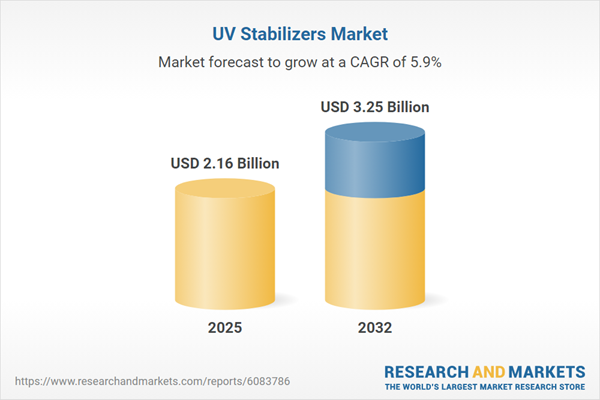Speak directly to the analyst to clarify any post sales queries you may have.
The UV Stabilizers Market is evolving rapidly as sectors adapt to rising environmental standards, regulatory measures, and the need for durable polymer solutions. Senior executives and procurement leaders are taking note of the shifting technologies and geographic trade dynamics shaping material protection strategies across industries.
Market Snapshot: UV Stabilizers Market
The UV stabilizers market grew from USD 2.05 billion in 2024 to USD 2.16 billion in 2025, maintaining a consistent expansion with an anticipated CAGR of 5.93% and is projected to reach USD 3.25 billion by 2032. This performance reflects robust, sustained demand for advanced UV protection in polymer and plastic applications spanning automotive, construction, electronics, packaging, and textiles. Key contributors include ongoing infrastructure investments, accelerating adoption of sustainable chemistries, and regulatory drivers across established as well as emerging regions.
Scope & Segmentation
This report delivers an in-depth analysis of the UV stabilizers market, covering key products, forms, end uses, major regions, and company trends. Segmentation enables stakeholders to align growth strategies with evolving market needs and competitive positioning.
- Product Types: Hindered Amine Light Stabilizers, UV Absorbers (including Benzophenones, Benzotriazoles, Triazines), and UV Quenchers.
- Form Factors: Liquid, Pellet, Powder.
- End Use Industries: Automotive (Exterior, Interior), Construction (Floorings, Roof Coatings, Sealants), Electronics (Coatings, Encapsulation), Packaging (Flexible, Rigid), Textiles (Apparel, Outdoor Fabrics).
- Geographic Coverage: Americas (United States, Canada, Mexico, Brazil, Argentina, Chile, Colombia, Peru), Europe, Middle East & Africa (United Kingdom, Germany, France, Russia, Italy, Spain, Netherlands, Sweden, Poland, Switzerland, United Arab Emirates, Saudi Arabia, Qatar, Turkey, Israel, South Africa, Nigeria, Egypt, Kenya), Asia-Pacific (China, India, Japan, Australia, South Korea, Indonesia, Thailand, Malaysia, Singapore, Taiwan).
- Leading Companies: AkzoNobel N.V., BASF SE, Adeka Corporation, Altana AG, Ampacet Corporation, Baoding Lucky Chemical Co., Chitec Technology Co., Clariant AG, Eastman Chemical Company, Everlight Chemical Industrial, Everspring Chemical, Evonik Industries AG, Greenchemicals S.r.l., KNV Chemicals Inc., Lycus Ltd., Mayzo Inc., MPI Chemie BV, Phoenix Plastics, Rianlon, Riverdale Global, SABO S.p.A., SI Group, SONGWON Group, Unitechem Group, Valtris Specialty Chemicals.
- Core Technologies & Trends: Renewables-based chemistries, digitalized formulation optimization, advanced analytical monitoring, and AI-powered degradation modeling.
Key Takeaways for Decision-Makers
- UV stabilizers are essential for ensuring the long-term durability and safety of polymers exposed to harsh environmental conditions, supporting quality and brand integrity across value chains.
- Innovative chemistries are emerging that respond to both sustainability imperatives and new regulations, thereby reducing environmental impact while retaining or enhancing product performance.
- Digitalization and automation now enable real-time optimization of stabilizer integration, reducing operational waste and providing more predictable performance results in diverse applications.
- Rising regulatory stringency, especially in Europe and North America, is driving demand for low-migration, non-toxic, and recyclable stabilizer options, influencing product development pipelines globally.
- Mid-sized and specialized suppliers are capitalizing on market niches by delivering customized solutions and collaborative application development, increasing competition amid larger, established players.
Tariff Impact
The US-imposed tariffs in 2025 have significantly influenced the UV stabilizers supply chain. Elevated duties on imports have led buyers to reassess supplier portfolios, with many shifting towards domestic sources, regional partnerships, or joint manufacturing ventures to secure steady supply and manage volatility. The changes extend beyond cost, prompting shifts in innovation investment as local producers expand R&D to advance new stabilizer solutions and reduce reliance on affected imports.
Methodology & Data Sources
The research is based on structured interviews with market executives, primary site visits, and thorough review of scientific literature, technical bulletins, and regulatory documents. Data triangulation anchored by both bottom-up and top-down approaches, and validation with subject matter experts ensures accuracy and actionable insights.
Why This Report Matters
- Clarifies the strategic importance of UV stabilizer adoption for durable product manufacturing and risk mitigation.
- Equips executives and procurement leads with segmentation insights to navigate regulatory shifts and supply chain pressures in real time.
- Identifies actionable innovation and sourcing strategies that anticipate future market disruption and environmental requirements.
Conclusion
This report offers actionable, executive-ready guidance for navigating the UV stabilizers landscape amid regulatory, technological, and supply chain change. Market leaders that align innovation, procurement, and compliance priorities will be best positioned for sustained success.
Table of Contents
3. Executive Summary
4. Market Overview
7. Cumulative Impact of Artificial Intelligence 2025
Companies Mentioned
The companies profiled in this UV Stabilizers market report include:- AkzoNobel N.V.
- BASF SE
- Adeka Corporation
- Altana AG
- Ampacet Corporation
- Baoding Lucky Chemical Co., Ltd.
- Chitec Technology Co., Ltd.
- Clariant AG
- Eastman Chemical Company
- Everlight Chemical Industrial Corporation
- Everspring Chemical Co., Ltd.
- Evonik Industries AG
- Greenchemicals S.r.l.
- KNV Chemicals Inc.
- Lycus Ltd.
- Mayzo, Inc.
- MPI Chemie BV
- Phoenix Plastics
- Rianlon Corporation
- Riverdale Global LLC
- SABO S.p.A.
- SI Group, Inc.
- SONGWON Group
- Unitechem Group
- Valtris Specialty Chemicals Limited
Table Information
| Report Attribute | Details |
|---|---|
| No. of Pages | 189 |
| Published | November 2025 |
| Forecast Period | 2025 - 2032 |
| Estimated Market Value ( USD | $ 2.16 Billion |
| Forecasted Market Value ( USD | $ 3.25 Billion |
| Compound Annual Growth Rate | 5.9% |
| Regions Covered | Global |
| No. of Companies Mentioned | 26 |









